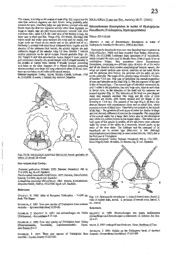
Discontinuous dimorphism in males of Hydropsyche kinzelbachi (Trichoptera, Hydropsychidae) PDF
Preview Discontinuous dimorphism in males of Hydropsyche kinzelbachi (Trichoptera, Hydropsychidae)
© Hans Malicky/Austria; download unter www.biologiezentrum.at 23 The scapus, is as long as the scapus of male (Fig. 22), scapus and the BRAUERIA (Lunz am See, Austria) 28:23 (2001) next four antennal segments are dark brown, being gradually paler towards the apex; maxillary palps are pale brown; covered with dark Discontinuous dimorphism in males of Hydropsyche brown hairs; the first two segments and the other three segments are kinzelbachi (Trichoptera, Hydropsychidae) equal in length; legs are pale brown-yellowish; covered with short and dense hairs; spurs 2,4.4; the outer spur of the foreleg is long, the inner spur is short and thin. Wings (Fig. 23) brown; forewing with Fiisun SIPAHILER scarce small and white spots between the costa and the media; two larger spots are found on the media and on the apical end of Al; Abstract. A case of discontinuous dimorphism in males of hindwing is covered with short black thickened hairs; tergites and the Hydropsyche kinzelbachi MALICKY, 1980 is described. sternites of the abdomen dark brown; the pleural regions are pale yellowish; length of the anterior wing 5.5 mm. Sternite 7 without Hydropsyche kinzelbachi MALICKY was described from Euphrates in median projection on the apical margin. Female genitalia (Figs. 24- Syria (MALICKY, 1980) and later recorded from Turkey (SIPAHILER, 26): Tergite 8 with thin dorsomedian carina; tergite 9 short, anterior 1993). On 17.6.2000, I collected many specimens of H. kinzelbachi, part sclerotized; dorsally, the apical margin with U-shaped excision in which included 90 males and 25 females from Dicle (Tigris) River in the middle; in ventral view, sternite 9 broadly excised, protruding southeastern Turkey. This population shows discontinuous oval lobes on the sides. Segment 10 is dilated dorsally, protruding dimorphism, composing two different types of males. 83 of the males almost rounded, very large and long sclerotized plate; in dorsal view, and all the females have similar morphological features namely, the there are two lobes on the sides of the apical margin. wings are almost uniform pale brown; tubercles on the head, thorax Material examined: Turkey, Artvin, Borçka, Camili, Lodivale, 1750 and the abdomen dark brown; the antennae and the palps are pale m, 12.8.2000, (5 males, 1 female), leg. and coll. Sipahiler. brown-yellowish. The length of the anterior wings of males is 5-6 mm, of females 7.5-8 mm. This type of individual has normal proportions of eyes and tubercles on the head (Fig 1). The last segment of the tarsi is also of normal type. - The second type of individual represented by only 7 males in the population, has very large eyes, close to each other in dorsal view, so the tubercles of the head and the antennae are pressed together (Fig. 2). The tubercles of the head are pear-shaped, rather than normally rounded. The wings and the veins of these specimens are brown, dark brown spotted and the length of the forewing is 7.5-8 mm. The pretarsi of the legs (Fig.3, 4) have also aberrant features with asymmetrical claws and an apical lobe, which possesses a brush of black hairs. These lobes are located on the outside of the legs. - The genitalia of both types of males are similar in shape and size; the only difference is seen on the coxopodite. The coxopodite of the normal males has a large, dark brown spot on the dorsoapical part, while it is uniform brown in the mutant types. - The behaviour of both types of this species is similar, all the specimens were collected under the covers of the tables in a restaurant, located partly in the water of the river shore. The holotype and the paratypes of H. kinzelbachi are in normal type (MALICKY, in litt). Although polymorphism occurs frequently in insect orders (MAYR, 1967), this is the first case in Trichoptera. Material examined: Turkey, Batman, Hasankeyf, 400 m, 17.6.2000, Dicle (Tigris) Nehri, 90 males, 25 females, leg. & coll. Sipahiler. Figs. 24-26: Martynomyia ayderensis SIPAHILER, female genitalia: 24 lateral, 25 dorsal, 26 ventral. New records from Turkey: Ecnomus gedrosicus SCHMID, 1959: Batman, Hasankeyf, 400 m, 17.6.2000, leg. & coll. Sipahiler. Plectrocnemia intermedia MARTYNOV, 1917: Edremit, Güre-Zeytinli, Kazdag, 7.8.1994, leg.& coll. Sipahiler. Limnephilus extricatus McLACHLAN, 1865: Ankara, Kizilcahamam, AkyarmaGeçidi, 1200 m, 16.6.2000, leg.& coll. Sipahiler. References MALICKY, H. 1983: Atlas of European Trichoptera. - X+298 pp. . , i, head of normal male, dorsal; 2, pgs XA Hydropsyche hnzdhacU: Junk. The Hague. j p rsus of mutant male, lateral; 4, head of mutant maCj dorsal; 3> reta SIPAHILER, F. 1987: Two new species of Trichoptera from northern 0> ventra * Anatolia.- Spixiana(München) 10:93-96. References SIPAHILER, F. MALICKY, H. 1987: Die Köcherfliegen der Türkei MALICKY, H. 1980: Beschreibungen von neuen mediterranen (Trichoptera). - Entomofauna 8:77-165. Köcherfliegen und Bemerkungen zu bekannten.- Z. ArbGem. öst. Ent., 32:1-17. SIPAHILER, F. 1989: Four new species of Trichoptera from Turkey (Glossosomatidae, Ecnomidae, Lepidostomatidae).- Opusc. MAYR, E. 1967: Artbegriff und Evolution. Parey, Hamburg, 617 pp. zool.flumin.39:l-7. SIPAHILER, F. 1996: Studies on the Trichoptera fauna of southern SIPAHILER, F. 1995: Three new species of Trichoptera from Anatolia.- Entomofauna (Ansfelden) 17:293-309. Anatolia.-Aquatic Insects 17:215-222.
